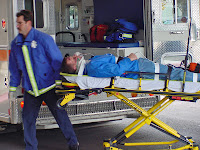Back during my early teen years in Pittsburgh, I was in a Boy Scout troop that was part of one of the Prep Pitt exercises. At the Civic Arena I got made up with a realistic looking broken arm. They used modeling clay, chicken bones, and fake blood. Apparently I had two broken bone ends poking through the skin. An ambulance took me over to Children’s Hospital, where I was bandaged and set aside so my “fracture” could be set later.
A decade later I was being trained as a medic by the Air Force. Everyone in the medical corp began tech school by taking a three week course called Medical Fundamentals that covered medical terminology, anatomy, physiology, first aid, etc.. It ended with a field program. Teams practiced carrying litters over an obstacle course. We learned about terminal ballistics (gunshot wounds). They taught us about triage - a process for sorting patients into four categories:
The injured who can be helped by IMMEDIATE transport
The injured whose transport can be DELAYED
Those with MINOR injuries, who need help less urgently
The EXPECTANT who are beyond help
Then they split us into medics and made-up patients for a realistic disaster exercise held at dusk. We ran through drizzle to find an airplane crash scene with a fuselage lit only by burning jet fuel in rows of split oil drums. Patients had been coached to scream and moan. Our only supplies were a jeep trailer with bandages, etc. We tried get the casualties sorted, treated, and away from the fuselage.
I remember that one man with minimal injuries had been coached to wander around and realistically pester the medics. Three of the biggest medics were deputized to put him out of circulation. They grabbed some straps and a litter, and fastened him to the trunk of the largest tree in the vicinity. Problem solved.
After ten minutes or so our instructors declared that the fuel tanks on the plane had exploded, and everyone within a hundred feet was dead. By then we’d already sorted and removed almost all the patients from harm’s way.
Three years later I was working as a medic at an Air Force Reserve weekend at Greater Pittsburgh International Airport. On Sunday afternoon the crash phone rang. We loaded up our ambulance and joined the fire department and Air National Guard on the edge of the runway. Then we waited for an Air National Guard tanker aircraft to make an emergency landing on a wet runway with two of four engines shut down. They didn’t crash, but we were prepared for it.
Those four triage categories are still used in a common system known as Simple Triage and Rapid Treatment (START). The obscure military usage of the word Expectant was replaced with the word Deceased.
Last week I was listening to Nanci Griffith’s latest CD. The next to the last song is Davey’s Last Picture, which is about New York City firefighter David Halderman, Jr., who was killed at the World Trade Center on September 11th, 2001.
The image of an ambulance came from Wikimedia Commons.


No comments:
Post a Comment